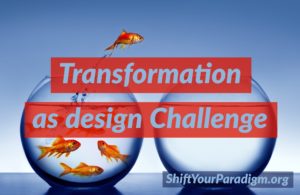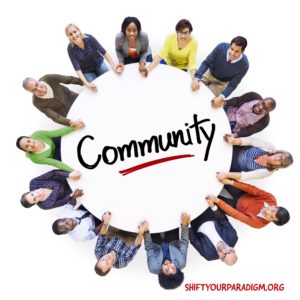This post is part of a series connected to the podcast Shift Your Paradigm: from school-centered to learner-centered. My colleague, Randy Ziegenfuss, and I will be sharing our learning and thinking along the way and cross-posting to the Shift Your Paradigm site.
Lynn Fuini-Hetten and Randy Ziegenfuss, Ed.D

In Episode 14, we had an engaging conversation with Sonya Wrisley, Neel Pujar and Stacey Lamb from Design39Campus in CA. There were lots of takeaways as we listened to the story of designing a school to creating the conditions for intentional conversations about what to give up from the old school-centered model. One of the most significant parts of the conversation had to do with the intentionality of letting aspects of the school-centered system go.
Key Competency
When working with a small team of leaders and learners to design Design39Campus, principal Sonya Wrigley created space for the team to have intentional conversation about aspects of the school-centered system to let go. Learner-centered leaders are intentional about what is being given up in the transformation. Here is what they discussed letting go: control and power, teacher isolation, territory, traditional classroom spaces with “stuff,” learning only happening at a desk, homework for homework’s sake, grade level boundaries.
Key Takeaways
It takes time to create a sustainable vision for transformation. As principal, Sonya worked on this for two years. She researched other school models around the country that exemplified key principles – a school designed with the learner in mind, collaborative community, design thinking, global connections, inquiry, technology and other real world tools, and a growth mindset poised to change the world.
Learner voice was a key factor in the development of the school. Through a design thinking model, learners were asked, “Why are schools built the way they are?”
As they engaged in the design thinking process, they thought deeply about what to let go of during this transformation:
- They wanted to reduce the isolation and concept of territory. Teachers (learning experience designers) would not have their own classrooms, and Sonya would not have her own office. Instead they created community learning spaces for learners, and the open collaboration areas became design studios.
- They thought intentionally about traditional school-centered spaces and how they needed to be modified for this new school. Teachers were asked to “dump their stuff.” Instead, they created “makeries” by contributing all of their “making” supplies to the learning community. Classroom books were moved to the loft so students could borrow resources which interested them.
- Giving up control was one of the biggest challenges. Teachers gave up the position of power or being a sage on the stage. Learners have knowledge, and the learning experience designers can learn from them, too.
- Traditional school-centered seating was also abandoned. Learners didn’t have to be seated at a desk to be learning; learning takes place everywhere from hallways to community learning spaces.
- Homework akin to doing 20 math problems was no longer acceptable. Instead, homework was completed when the learning naturally extended beyond the school day because learners didn’t want to stop what they were doing.
- Grade level boundaries evolved into learners learning at a pace that was appropriate for them.
While engaging in the design and implementation, the team mitigated some barriers. They had to learn to trust the community – including their colleagues. Team members needed to rely on each other because no one person can do this work. The team reflected on its work continuously, made modifications and will continue to assess their work.
They needed to shift mindsets and perceptions – particularly in the parent and school community. Everyone needed to understand this is not the school they attended in the past. Design39Campus conducted design workshops prior to and during the school year. About 100 people attended the sessions and talked through the ideas. Parent tours were conducted to help parents experience the learning environment.
If they wanted to change the way they thought about something, they had to change the way they talked about it. In addition to classrooms becoming learning spaces, the administration building was referred to as the welcome center. The shift in language helped the community understand the differences.
Design39Campus discovered the more voice/choice learners have, the more agency. Learners take control of their behavior, thoughts, and actions. They take control of themselves, and changes are evident. For example, issues on the playground have decreased as a result of learners taking control, solving problems, and taking leadership – even in social situations. Learners are empowered with trust and ownership and they then want to make their learning space the best space possible.
Shifting the paradigm of education is not easy and it is not quick. It is hard work. In education, we need to build empathy for one another. We need to listen to understand where others are coming from in their thinking.
Design39Campus team members shared advice with our listeners. They encourage us to start small and make some changes with the learners in our schools. They encourage us to let go of control and share the leadership. We need to encourage teachers to fail forward and fail fast. The environment has to support this with strong trust.
Connections to Practice
- The design thinking process is woven through this experience. We have been iterating our professional learning over the past few years. We have also iterated leadership team meetings and goals. Where else can we iterate? Where can we start?
- It is essential to develop trust across the organization in order to provide the space for risk-taking and failing. As leaders, we need to be explicit about this expectation. How well are we communicating this across the organization?
- To shift our mindset, we need to intentionally shift our vocabulary. As we learn and talk with other practitioners, our language is evolving. We will work with our Leading #YourSalisbury professional learning cohort to develop our own lexicon.
- We need to provide opportunities for collaboration. Teachers work in PLCs through grade level teams, departments, etc. What structures do we have in place to encourage collaboration? How can we best support out teachers and leaders when they are working in these groups? How can we engage their voice and choice to cultivate ownership?
Questions Based on Our Context
- Why are schools built the way they are?
- How can we more effectively engage our parents/community through school visits?
- What can we give up? Who needs to be involved in these conversation?
- How do we build empathy for one other?
Next Steps for Us
- Consider the above questions
- Identify areas we can “give up”
- Identify a strategy for getting started on our lexicon

 In
In  In
In